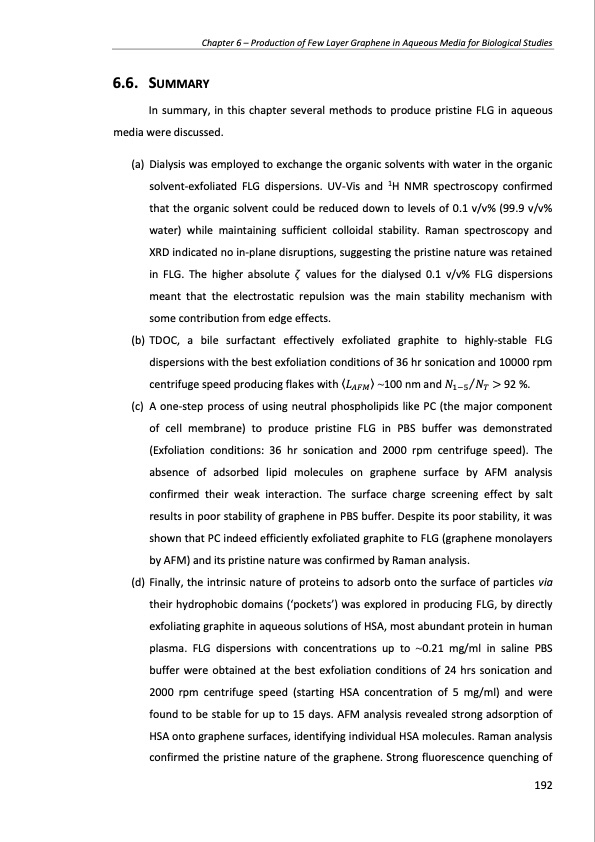
PDF Publication Title:
Text from PDF Page: 192
Chapter 6 – Production of Few Layer Graphene in Aqueous Media for Biological Studies 6.6. SUMMARY In summary, in this chapter several methods to produce pristine FLG in aqueous media were discussed. (a) Dialysis was employed to exchange the organic solvents with water in the organic solvent-exfoliated FLG dispersions. UV-Vis and 1H NMR spectroscopy confirmed that the organic solvent could be reduced down to levels of 0.1 v/v% (99.9 v/v% water) while maintaining sufficient colloidal stability. Raman spectroscopy and XRD indicated no in-plane disruptions, suggesting the pristine nature was retained in FLG. The higher absolute 𝜁 values for the dialysed 0.1 v/v% FLG dispersions meant that the electrostatic repulsion was the main stability mechanism with some contribution from edge effects. (b) TDOC, a bile surfactant effectively exfoliated graphite to highly-stable FLG dispersions with the best exfoliation conditions of 36 hr sonication and 10000 rpm centrifuge speed producing flakes with 〈𝐿𝐴𝐹𝑀〉 ~100 nm and 𝑁1−5⁄𝑁𝑇 > 92 %. (c) A one-step process of using neutral phospholipids like PC (the major component of cell membrane) to produce pristine FLG in PBS buffer was demonstrated (Exfoliation conditions: 36 hr sonication and 2000 rpm centrifuge speed). The absence of adsorbed lipid molecules on graphene surface by AFM analysis confirmed their weak interaction. The surface charge screening effect by salt results in poor stability of graphene in PBS buffer. Despite its poor stability, it was shown that PC indeed efficiently exfoliated graphite to FLG (graphene monolayers by AFM) and its pristine nature was confirmed by Raman analysis. (d) Finally, the intrinsic nature of proteins to adsorb onto the surface of particles via their hydrophobic domains (‘pockets’) was explored in producing FLG, by directly exfoliating graphite in aqueous solutions of HSA, most abundant protein in human plasma. FLG dispersions with concentrations up to ~0.21 mg/ml in saline PBS buffer were obtained at the best exfoliation conditions of 24 hrs sonication and 2000 rpm centrifuge speed (starting HSA concentration of 5 mg/ml) and were found to be stable for up to 15 days. AFM analysis revealed strong adsorption of HSA onto graphene surfaces, identifying individual HSA molecules. Raman analysis confirmed the pristine nature of the graphene. Strong fluorescence quenching of 192PDF Image | PRODUCTION AND APPLICATIONS OF GRAPHENE AND ITS COMPOSITES

PDF Search Title:
PRODUCTION AND APPLICATIONS OF GRAPHENE AND ITS COMPOSITESOriginal File Name Searched:
graphene-production-applications.PDFDIY PDF Search: Google It | Yahoo | Bing
Salgenx Redox Flow Battery Technology: Power up your energy storage game with Salgenx Salt Water Battery. With its advanced technology, the flow battery provides reliable, scalable, and sustainable energy storage for utility-scale projects. Upgrade to a Salgenx flow battery today and take control of your energy future.
| CONTACT TEL: 608-238-6001 Email: greg@infinityturbine.com | RSS | AMP |